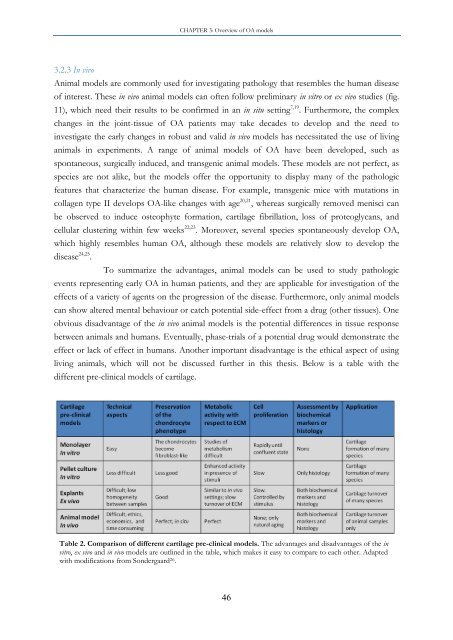Identification of important interactions between subchondral bone ...
Identification of important interactions between subchondral bone ...
Identification of important interactions between subchondral bone ...
Create successful ePaper yourself
Turn your PDF publications into a flip-book with our unique Google optimized e-Paper software.
3.2.3 In vivo<br />
CHAPTER 3: Overview <strong>of</strong> OA models<br />
Animal models are commonly used for investigating pathology that resembles the human disease<br />
<strong>of</strong> interest. These in vivo animal models can <strong>of</strong>ten follow preliminary in vitro or ex vivo studies (fig.<br />
11), which need their results to be confirmed in an in situ setting 7,19 . Furthermore, the complex<br />
changes in the joint-tissue <strong>of</strong> OA patients may take decades to develop and the need to<br />
investigate the early changes in robust and valid in vivo models has necessitated the use <strong>of</strong> living<br />
animals in experiments. A range <strong>of</strong> animal models <strong>of</strong> OA have been developed, such as<br />
spontaneous, surgically induced, and transgenic animal models. These models are not perfect, as<br />
species are not alike, but the models <strong>of</strong>fer the opportunity to display many <strong>of</strong> the pathologic<br />
features that characterize the human disease. For example, transgenic mice with mutations in<br />
collagen type II develops OA-like changes with age 20,21 , whereas surgically removed menisci can<br />
be observed to induce osteophyte formation, cartilage fibrillation, loss <strong>of</strong> proteoglycans, and<br />
cellular clustering within few weeks 22,23 . Moreover, several species spontaneously develop OA,<br />
which highly resembles human OA, although these models are relatively slow to develop the<br />
disease 24,25 .<br />
To summarize the advantages, animal models can be used to study pathologic<br />
events representing early OA in human patients, and they are applicable for investigation <strong>of</strong> the<br />
effects <strong>of</strong> a variety <strong>of</strong> agents on the progression <strong>of</strong> the disease. Furthermore, only animal models<br />
can show altered mental behaviour or catch potential side-effect from a drug (other tissues). One<br />
obvious disadvantage <strong>of</strong> the in vivo animal models is the potential differences in tissue response<br />
<strong>between</strong> animals and humans. Eventually, phase-trials <strong>of</strong> a potential drug would demonstrate the<br />
effect or lack <strong>of</strong> effect in humans. Another <strong>important</strong> disadvantage is the ethical aspect <strong>of</strong> using<br />
living animals, which will not be discussed further in this thesis. Below is a table with the<br />
different pre-clinical models <strong>of</strong> cartilage.<br />
Table 2. Comparison <strong>of</strong> different cartilage pre-clinical models. The advantages and disadvantages <strong>of</strong> the in<br />
vitro, ex vivo and in vivo models are outlined in the table, which makes it easy to compare to each other. Adapted<br />
with modifications from Sondergaard 26 .<br />
46

















